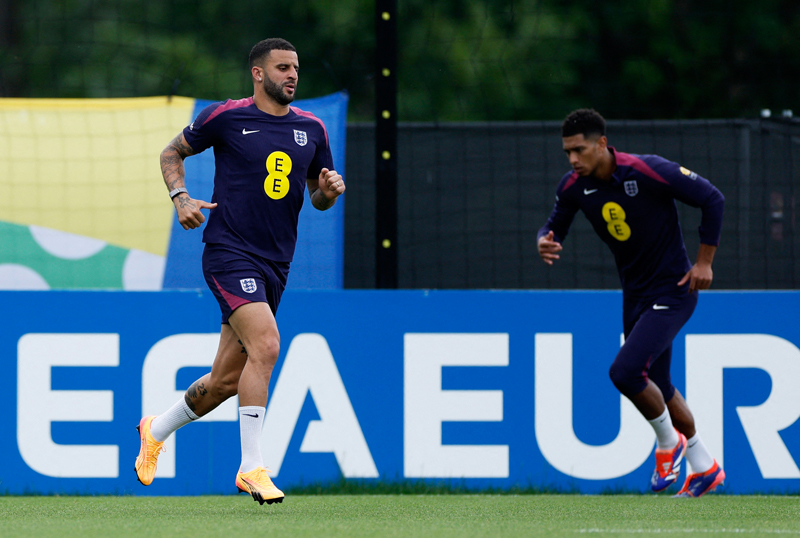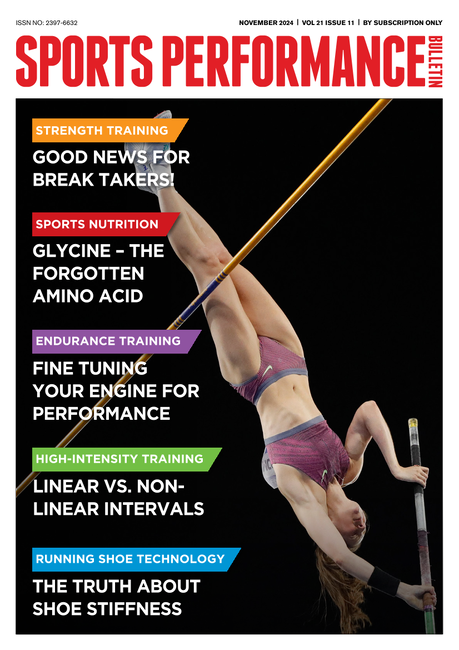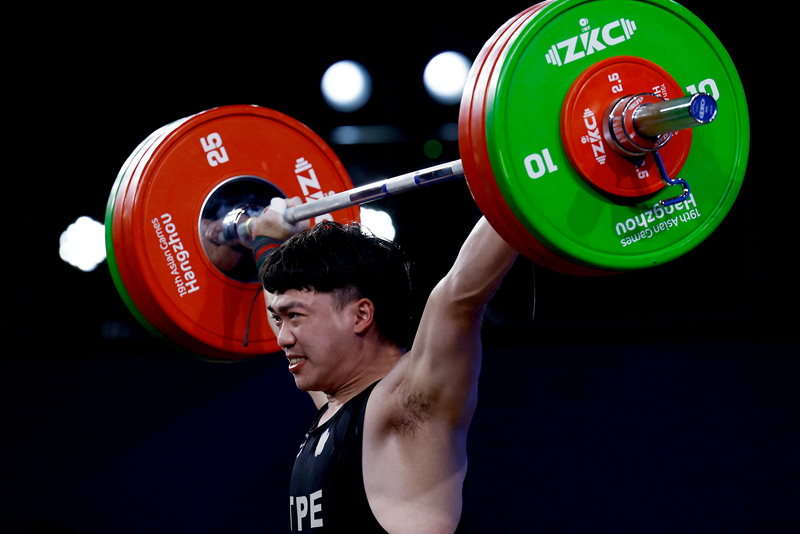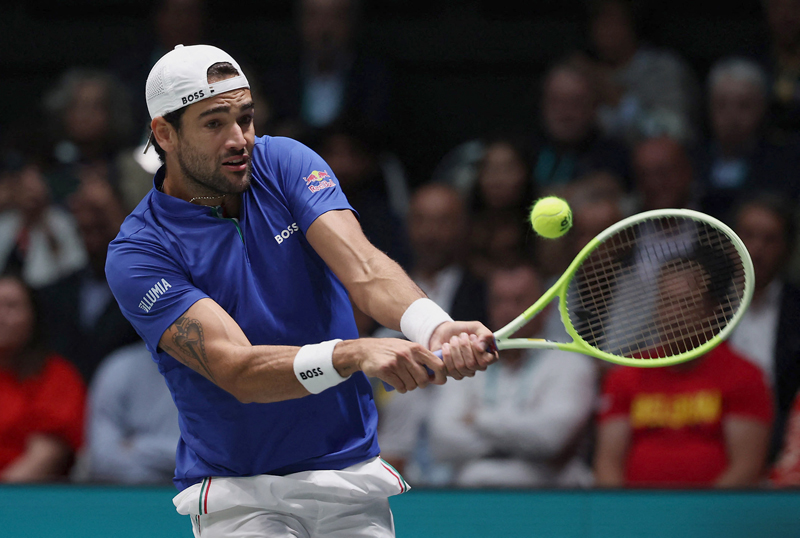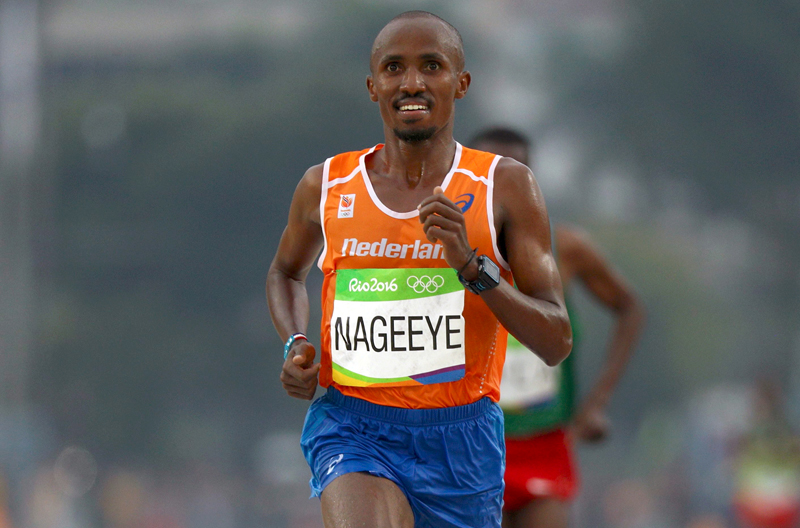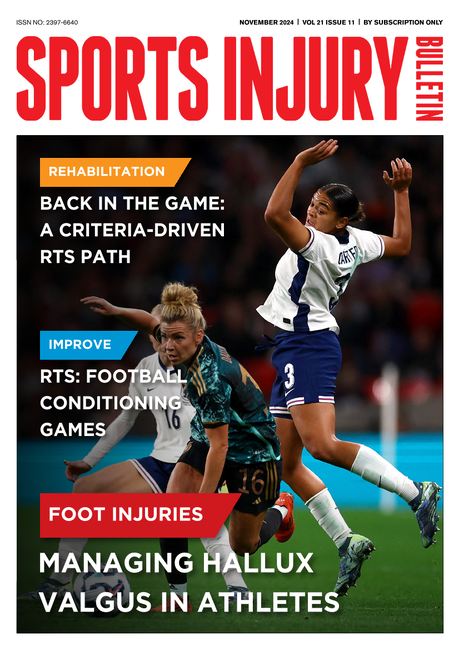You are viewing 1 of your 1 free articles. For unlimited access take a risk-free trial
Sprint training for team sports: head to the beach!
Does the running surface matter when performing sprint training, and if so, which type of surface produces the best gains? SPB looks at new research to get answers
High levels of aerobic fitness and excellent athletic performance tend to go hand in hand. In pure endurance sports such as distance running, cycling, swimming etc, high maximum levels of oxygen uptake (VO2max) and the ability to use a large percentage of this maximum oxygen uptake over sustained periods of time are very predictive of an athlete’s performance(1). However, when it comes to team sports such as soccer, rugby, basketball etc, it’s not quite so simple. In soccer and rugby for example, the intermittent nature of the sport involves various sporadic but high-intensity actions such as changes of direction, high-intensity running, sprinting and jumps(2).
The important of high-intensity running and sprint ability in team sports
Let’s take a closer look at the importance of high-intensity performance in team sports using soccer as an example. Although much of the energy expended on the pitch during a game occurs during walking, jogging and running, the total distance covered during a soccer game is actually a poor gauge of the physical demand placed on a player. Instead, it is the distance covered performing high-intensity running/sprinting/jumping that is a more valid and reliable indicator of a player’s performance capability – even though it constitutes a much smaller proportion of a player’s activity profile (see figure 1). Data gleaned from research into soccer players shows why this is the case(3):
· It is during high-intensity periods of play that the outcome of a game is often decided.
· During the second half of a game, the volume of high-intensity running can be 35 to 45% less than in the first half, without a reduction in low-intensity running.
· A defining characteristic of elite soccer players is that they run further at a high-intensity during a game compared to moderate-standard players.
· To gain an improvement in fitness that will benefit soccer performance (and other team sports performance), it is imperative that training should include not only endurance sessions, but also training elements designed to improve a player’s capability to perform intermittent high-intensity exercise – eg intermittent sprint training.
Figure 1: Positional breakdown of workload intensity during an English Premiership game
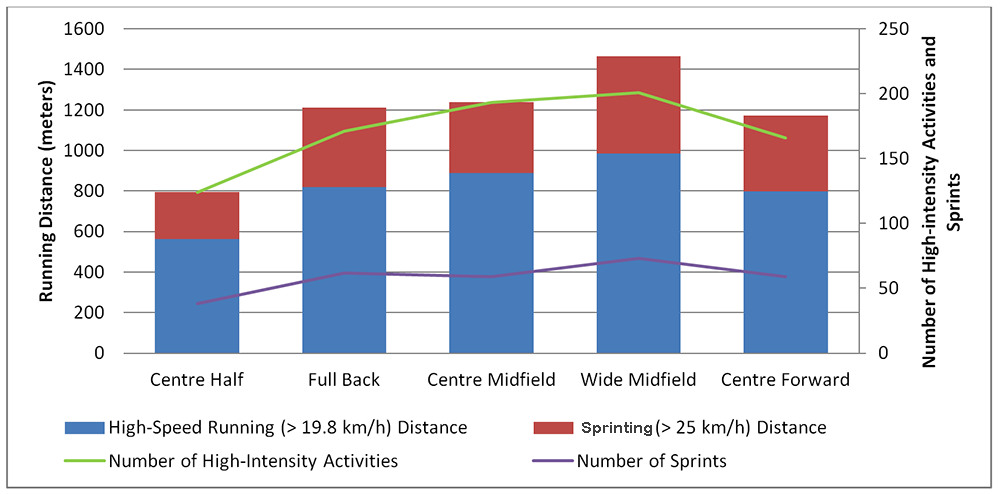
Training for high-intensity tasks on the pitch
Because excellent team sport performance requires both good levels of base endurance fitness and the ability to perform repeated high-intensity burst of activity, a fitness training program needs to focus on enhancing both aerobic metabolic pathways (for sustained endurance) and anaerobic pathways (for high-intensity bursts) in order to elevate performance on the pitch(4). There are a number of ways that team sport players can train to improve both aerobic and anaerobic fitness within a single session. These include:
· Traditional running-based high-intensity interval sessions(5)
· Small-sided games(6)
· Sprint-interval sessions(7)
Of these methods, research has shown that performing repeated short bursts of all-out running in the form of short sprint intervals (around 10 seconds duration per interval) can result in similar adaptive responses to traditional long-duration interval training, but with less resulting fatigue(8). In addition, the same research has shown that short sprint intervals are much easier than longer intervals psychologically for players, who tend to stay more motivated during training sessions as a result.
Sprint interval training and running surface
If you’ve ever done running training (at any speed) on a sandy beach, in the snow, or over muddy fields, you will know that the terrain underfoot has a huge impact on the effort level and energy expenditure required. In short, compared to a sidewalk, tarmac road, hard grass surface or running track, running on sand, snow or soft ground requires significantly more energy for any given speed and gradient.
Get off a tarmac road or pavement, and, energy output rises dramatically. To illustrate this, table 1 gives ‘correction factors’ for different terrains(9). Multiplying the figure for energy expenditure on a smooth tarmac road or running track by the correction factor gives you an indication of how much energy you’d need to maintain your speed at the same gradient over a different terrain. For example, walking at 4mph on a flat smooth surface such as a sidewalk burns 400cals per hour (for an 80kg adult). For the same speed over a flat ploughed field, the energy requirement would rise to 1.5 x 400 = 600cals per hour. It follows therefore that the surface used during any sprint interval training sessions will significantly impact the training stimulus that arises from those sessions.
Table 1: the effect of terrain on walking energy expenditure*
|
Terrain |
Correction Factor |
|
Paved road or smooth track |
1.0 |
|
Ploughed field |
1.5 |
|
Hard snow |
1.6 |
|
Soft sand |
1.8 |
*Data from Richmond, Potter and Santee: ‘Terrain factors for predicting walking and load carriage energy costs: review and refinement’ J. Sport Hum. Perform., 3 (3) (2015), pp. 1-26
Comparing running surfaces for sprint interval training
If energy expenditure while running on soft surfaces such as sand is much higher, could this be leveraged in order to improve the training response to a sprint interval session? Some research conducted last year seems to support this idea(10). This study looked at both sprint and jump training performed on sand and grass, and found that both surfaces improved change of direction ability. Perhaps more importantly, training on sand led to more significant improvements in linear sprint gains compared to training on grass. Sprint training on sand may have other benefits too; it not only reduces impacts on joints and ligaments, but also increases the recruitment of muscle fibres to overcome energy losses, making it easier to produce the high levels of lactate required to train the lactate system for better performance(11).
However, there are potential downsides to sprint training on soft surfaces. In particular, it has been suggested that the friction properties of sand could have detrimental effects on various aspects of training, such as the stretch-shortening cycle and muscle recruitment patterns, leading to a subtly altered running gait, which in turn could result in a decline in performance adaptations(12). In this respect, sprint training on harder surfaces such as tarmac or a running track might be preferable. The problem is that up until now, there’s been no research directly comparing the effects hard surfaces (tarmac, track etc) and soft surfaces (sand, grass etc) on the outcomes of sprint interval training, particularly in team sport athletes.
New research
The good news is that brand new research just published in the ‘Journal of Sports Science and Medicine’ provides answers to this question(13). In this study, researchers from China compared the effects of sprint interval training performed for seven weeks on sand, grass, and a tartan track surface on physical performance adaptations in female soccer players. In particular, they measured performance in vertical jump capacity, 20m linear sprint speeds, change of direction speeds, the Yo-Yo incremental test to exhaustion, 2.4 km running time trial times and maximal kicking distance. In addition, they also measured the inter-individual variability in responses to this sprint training on various surfaces to see if there were particular surfaces that were suited to particular players (or whether it was a ‘one size fits all’ outcome).
Forty collegiate trained female soccer players with the same training habits and loads were enrolled in the study. All were experienced with various types of interval training but none had engaged in sprint interval training in the previous six months. The players were matched based on their playing positions and then randomly divided into four groups:
· Sand training – sprint interval training performed on sand in addition to normal soccer training.
· Grass training - sprint interval training performed on grass in addition to normal soccer training.
· Land training - sprint interval training performed on a tartan surface running track in addition to normal soccer training.
· Control group – no sprint interval training, but soccer training as normal.
What they did
Before and after a 7-week training period, all the participants underwent a series of field-based tests to evaluate key aspects of performance. These were as follows:
· Countermovement jump (CMJ) performance - commonly utilized in soccer performance assessments as an objective measure for assessing lower limb power(14).
· The 20-m linear sprint test - players were instructed to perform three maximal runs with a three-minute rest in between, and the best time was recorded for further analysis.
· The Illinois change of direction (CoD) speed test - to evaluate the agility of soccer players in terms of their acceleration, deceleration, multidirectional movement, and running at various angles on a grass field.
· The Yo-Yo Intermittent Recovery Test 1 (Yo-Yo IR1) - created to mirror the intermittent nature of soccer, which requires players to engage in bursts of intense physical activity that place demands on both anaerobic and aerobic metabolic systems.
· A 2.4km time trial test - following an 800m warm-up run and a 4-minute rest period, the players completed a 2400m run on the soccer pitch, with timing recorded to the nearest second using a stopwatch.
· Maximal kicking distance assessment - participants executed a maximal instep kick with their dominant leg directed toward a goal net, and were instructed to concentrate on attaining the maximum possible kicking distance. The best score of three kicks was recorded for further analysis.
All the soccer players trained in soccer practices on Mondays, Wednesdays, and Fridays) focusing on tactical and technical drills (passing, dribbling, change of direction with ball), small-sided games, and simulated competitive games, which took place on in the afternoon. Each training session lasted approximately two hours, comprising of 15 minutes of warm-up routine, 60-70-minute main soccer training and 15 minutes of cool-down (low intensity running and stretching exercises).
However, while the players in the control group only engaged in soccer practices, the sand, grass and land groups performed sprint interval training before each soccer training session. This sprint interval training consisted of a warm-up followed by 4 x sets of 10 repetitions, each requiring 5 seconds of all-out running, with a 50-second recovery period between each effort, and a 3-minute rest interval between sets. As a result, each training session in the sand, grass and land groups comprised a 15-minute warm-up, 50-52 minutes of sprint interval training, 60-70 minutes of soccer training, and a 15-minute cool-down.
What they found
At the end of the 7-week training intervention, the performance assessment tests were repeated and the researchers looked to see what kind of effect the three types of sprint interval training (on sand, grass and land) had produced. The main findings were as follows:
· Compared to the control group, all three training groups experienced significant positive changes in all of the performance assessment tests – indicating that the addition of sprint intervals on any surface had enhanced all aspects of performance.
· The control group experienced no pre-post testing gains in any of the performance tests.
· The players who trained on sand experienced a significantly greater gain in countermovement jump performance compared to the land group (9.6% vs. 5.2%).
· More generally, the gains achieved by the players in the sand training group tended to be greater than the other groups, although they weren’t quite large enough to reach statistical significance (a larger sample size would have probably confirmed this trend as significant). These gains were as follows (see figure 2): 20m linear sprint (SAND > GRASS = LAND, -4.1% vs. -3.0% vs. -2.9%). Illinois CoD test (SAND = GRASS > LAND, -3.2% vs. -3.4% vs. -2.3 %). Yo-Yo test (SAND > GRASS = LAND, 14.0% vs. 11.0% vs. 11.1%). 2.4km time trial (SAND > GRASS > LAND, -7.5% vs. -6.0% vs. 4.8%). Kick distance (SAND = GRASS > LAND, 9.3% vs. 9.5% vs. 8.5%).
· When sprint training on sand and grass, the inter-individuality was low, meaning that players who use this technique can expect a fairly uniform response (ie it’s not the case that there will be ‘responders’ and ‘non-responders’).
Figure 2: Comparison of before/after test results in each training intervention
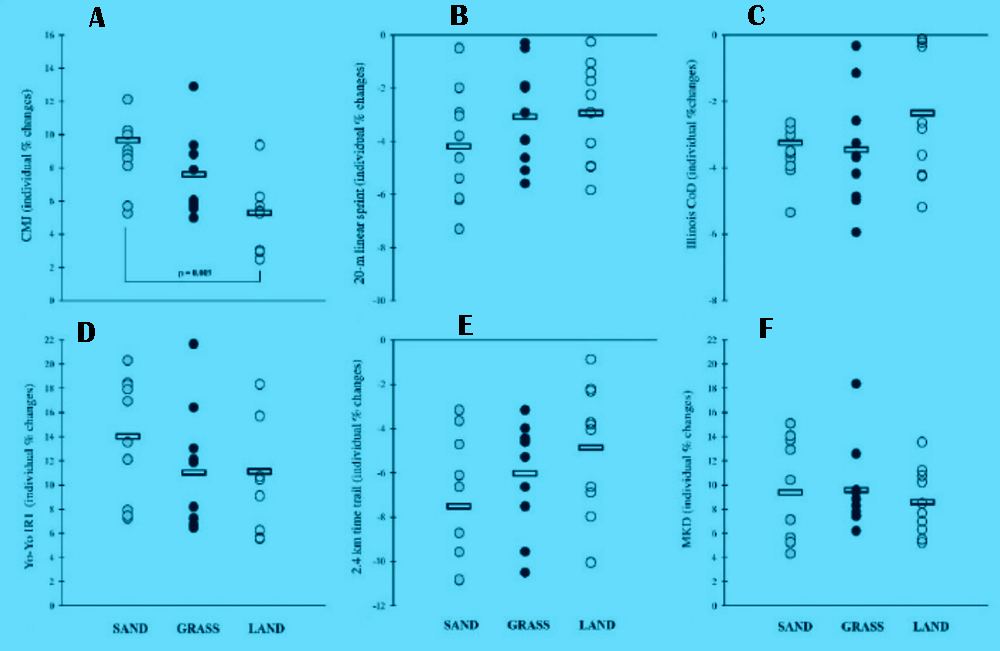
Implications for soccer and other team sport players
In their summing up, the authors concluded that “All training surfaces were effective in inducing significant adaptive changes to enhance the physical fitness of female soccer players following the 7-week sprint-interval intervention. Comparing the intervention, the sand group exhibited significantly greater improvements in countermovement jump performance compared to the land group”. And while the changes in other variables did not reach statistical significance, it was noted that “the sand group demonstrated greater gains in percent changes for the 20-m linear sprint and the Yo-Yo test compared to the grass and land groups. Additionally, the sand and grass groups displayed greater gains in the Illinois change of direction test and maximum kicking distance compared to the group.”
In terms of practical advice for soccer (indeed, all team sport) coaches and players, these findings suggest that there are real performance gains to be had by adding in very short sprint interval (5-second durations) sessions into a team-sport training program. In the study above, these sprint sessions were added after a warm up but before the soccer-specific training (ie while the muscles were fresh), and this is how the authors recommend that sprint intervals should be deployed in training sessions for players and coaches those who wish to try it.
As to which kind of surface produces the greater gains, the authors recommended that team sport players should perform sand sprints where possible. The theory mentioned above - that performing sprint intervals on sand alters the stretch-shortening cycle and muscle recruitment patterns, leading to a subtly altered running gait and reduced performance – seems to be disproven in this study (where a large number of performance metrics were tested). In particular, sand sprints led to much larger gains in countermovement jump performance. This is a significant finding; research shows that countermovement jump performance is a key indicator for soccer performance abilities, particularly for crucial skills like heading(15).
The researchers also recommended that where performing sprint intervals on a sand surface is not possible, the second best surface to train on would be grass; compared to training on a hard surface such as tarmac or a running track, grass tended to produce greater performance gains. However, it’s important to emphasize that compared to simply continuing with soccer training alone (ie no sprint intervals), adding in sprint intervals on ANY surface produced significant gains in all areas of performance. Therefore, coaches and team sport players should not be put off from adding these intervals into a training program just because a sand (or grass) surface isn’t available. The most important recommendation of all is to include sprint intervals in a team sport training program regardless of the available training surface(s)!
References
1. Int J Environ Res Public Health. 2021 Dec 17;18(24):13332
2. Apunts 2 72–93. 10.5672/apunts.2014-0983.es.(2018/2).132.06
3. Managing high-speed running load in professional soccer players’ SPSR 2019 March (53) volume 1
4. Sports 2017, 5 (3), 57
5. Biology of Sport 2020. 37(2), 165-173
6. Sports Medicine-Open 2019. 5(1), 1-13
7. Scand J Med Sci Sports 2022 32(5), 810-820
8. Frontiers in Physiology 2024. 15, 1377552
9. J. Sport Hum. Perform., 3 (3) (2015), pp. 1-26
10. Journal of Strength and Conditioning Research 2023. 37(9), 1828-1833
11. Interventional Medicine and Applied Science 2014. 6(3), 125-130
12. Sports 2016. 4, 15. doi.org/10.3390/sports4010015 10.3390/sports4010015
13. J Sports Sci Med. 2024 Jun; 23(2): 465–474
14. Football Science 2015. 12, 1-10
15. Strength and Conditioning Journal 2012. 34(3), 80-85
Newsletter Sign Up
Testimonials
Dr. Alexandra Fandetti-Robin, Back & Body Chiropractic
Elspeth Cowell MSCh DpodM SRCh HCPC reg
William Hunter, Nuffield Health
Newsletter Sign Up
Coaches Testimonials
Dr. Alexandra Fandetti-Robin, Back & Body Chiropractic
Elspeth Cowell MSCh DpodM SRCh HCPC reg
William Hunter, Nuffield Health
Keep up with latest sports science research and apply it to maximize performance
Today you have the chance to join a group of athletes, and sports coaches/trainers who all have something special in common...
They use the latest research to improve performance for themselves and their clients - both athletes and sports teams - with help from global specialists in the fields of sports science, sports medicine and sports psychology.
They do this by reading Sports Performance Bulletin, an easy-to-digest but serious-minded journal dedicated to high performance sports. SPB offers a wealth of information and insight into the latest research, in an easily-accessible and understood format, along with a wealth of practical recommendations.
*includes 3 coaching manuals
Get Inspired
All the latest techniques and approaches
Sports Performance Bulletin helps dedicated endurance athletes improve their performance. Sense-checking the latest sports science research, and sourcing evidence and case studies to support findings, Sports Performance Bulletin turns proven insights into easily digestible practical advice. Supporting athletes, coaches and professionals who wish to ensure their guidance and programmes are kept right up to date and based on credible science.
